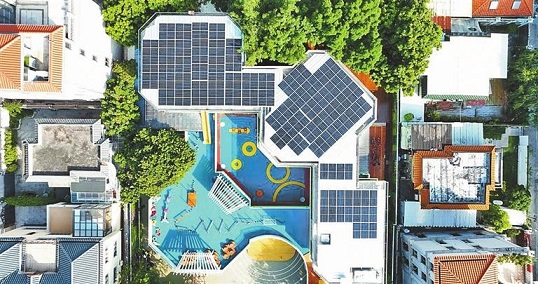Shenzhen
 2024/6/6
2024/6/6
 source: Shenzhen Daily
source: Shenzhen Daily
 Print
Print

Rooftop solar installations at Luohu District’s Yijing Kindergarten, a near-zero carbon campus pilot project.Daily Sunshine

Wang Jingli
wangjingli0715@163.com
A CARBON neutrality initiative for large-scale events was launched during a celebration for this year’s World Environment Day held in Futian District yesterday. It marks the city’s renewed dedication to pursuing a more sustainable and environmentally friendly path.
Representatives of local large-scale event organizers, such as the Greater Bay Area (GBA) Flower Show and the Shenzhen Marathon, vowed to achieve carbon neutrality at the ceremony.
Also at the ceremony, the Shenzhen Emissions Exchange announced its plan to build a carbon offset mechanism that is both transparent and traceable. The mechanism aims to ensure large-scale event organizers purchase offsetting products responsibly and efficiently while providing a platform for carbon offsetting.
In recent years, Shenzhen has made progress in its efforts to achieve peak carbon emissions and carbon neutrality, advancing its green and low-carbon development to a new phase.
The city has been included into the country’s first batch of 25 pilot cities that aim to reach peak carbon dioxide emissions.
By the end of last year, Shenzhen had built 128 national-level green factories. In a further move, the city will pilot green and low-carbon renovation projects at 100 industrial parks across the city this year.
Near-zero carbon
pilot projects
There are now 88 near-zero carbon emissions pilot projects in Shenzhen, including industrial parks, communities, campuses, buildings, and enterprises.
Visitors to the west square of the Shenzhen North Railway Station may have noticed a sunflower-shaped installation. This innovative structure is actually a movable, adjustable photovoltaic energy collection system designed to track the sun’s trajectory and automatically adjust its position, thereby increasing power generation efficiency by 40%.
The installation is part of the station’s photovoltaic green energy project, which is among the city’s first batch of near-zero carbon emissions pilot projects.
Advanced technologies, such as photovoltaic storage, vehicle-to-grid (V2G) system, super charging, and carbon emissions monitoring and management, were installed at the Futian power supply bureau of China Southern Power Grid building this March.
These technologies have enabled the 40-year-old building to save 420,000 kilowatt-hours of electricity annually and reduce carbon emissions by 189 tons. This reduction is equivalent to planting 10,000 trees.
Carbon emissions
trading
Shenzhen has taken multiple measures to continue to explore new green and low-carbon development paths.
Carbon emissions trading is a form of permit trading that serves as an important market-based instrument to limit carbon emissions.
In 2011, the National Development and Reform Commission approved seven pilot carbon trading programs in Beijing, Chongqing, Guangdong, Hubei, Shanghai, Shenzhen, and Tianjin.
Shenzhen was the first Chinese city to launch a carbon emissions trading market in 2013. This instrumental development made China the first developing country to establish a carbon trading market.
Over the past decade, Shenzhen’s carbon emissions trading market has recorded an accumulated trading volume of more than 100 million tons of carbon. This robust performance has cemented its position as a leader in carbon trading, with the annual turnover rate ranking first in the nation for several years running.
Social forces
As a city of volunteers, Shenzhen has encouraged public organizations to participate in green and low-carbon actions.
The Shenzhen Mangrove Wetlands Conservation Foundation organized a total of 1,615 activities last year that attracted more than 82,961 participants. Additionally, it carried out 61 mangrove education events for primary and secondary school students last year, according to its annual report.
The Shenzhen OCT Hua Ecological Environment Protection Foundation has promoted the exchange and sharing of the latest environmental protection concepts, technologies, and methods both at home and abroad. It has also carried out activities such as zero-waste programs and lectures that have resulted in more than 4 million residents recognizing the value of nature and practicing green lifestyles.





